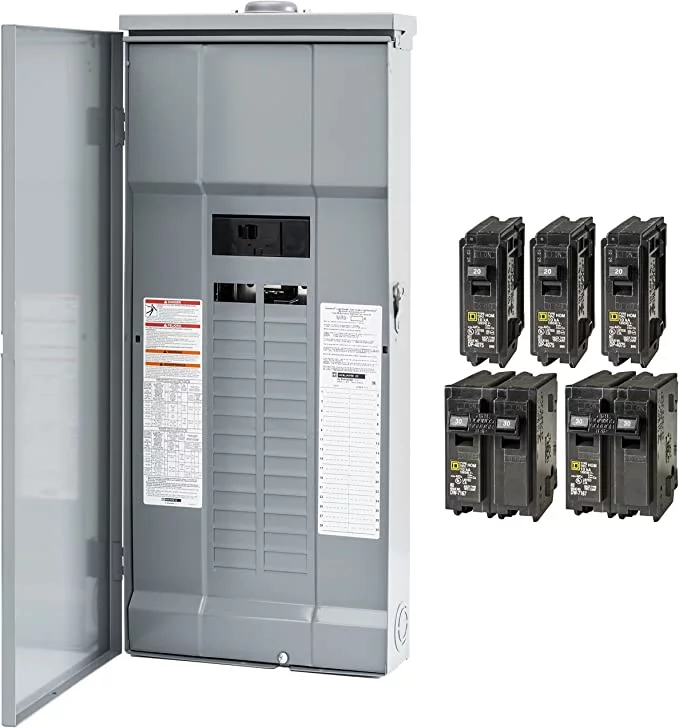Any electrical repair in your home requires you to switch off the power to the circuit you’ll be working on at the main electrical service panel. The service panel is also known as the breaker box, however it is formally known as a load center in the trade.
The main service panel functions as a switchboard for all of the home’s electricity. It gets power from the utility provider and distributes it to the numerous circuits that power the various lights, outlets, appliances, and other devices throughout the house. At the main service panel, everything but the incoming utility electricity can be turned off and on.
Located behind the Panel Door
A service panel is a steel box with a front hinged door or lift-up panel. All of the circuit breakers on the panel are accessible with the door open. Typically, one panel serves the entire house, but there may be a second, smaller panel, known as a subpanel, that serves a specialized section, such as an addition, a large kitchen, or a detached garage. A subpanel functions similarly to a main service panel, however it is powered by the main panel rather than the utility lines.
Each circuit breaker is controlled by a lever that can be manually set to ON or OFF. When a circuit breaker trips, usually due to an overload or other fault with the circuit, the lever moves to a third position between ON and OFF. Breakers should be labeled so that the principal area or appliance served by the breaker’s circuit may be identified. Stickers or handwritten text adjacent to breakers, or on a sheet fastened to the inside of the panel door, can serve as labels.
Note: In older residences that have not had their electrical services renovated, service panels with fuses may be used instead of circuit breakers, which have been standard since the 1960s.
Within the Service Panel
When the panel door is opened, you gain access to the circuit breaker switches, but that’s it. That’s all most homeowners need to know. To access inside the panel to install or repair a circuit breaker, you must first remove the dead front cover, which protects the breaker switches. A screw in each corner usually holds the dead front cover in place. By removing the cover, you gain access to all of the panel’s components. Some panels feature a distinct door and cover, while others have both as part of the same unit.
Before removing the dead front cover, always turn off the main circuit breaker (see next slide). This turns off the power to all circuit breakers and domestic circuits but does not turn off the utility power. Unless the utility provider turns off the service to the home, the utility service wires and the terminals they attach to within the panel remain live (carrying lethal electrical current).

Circuit Breaker (Main)
The main circuit breaker is a huge breaker that is normally found near the top of the panel but can also be found near the bottom or along one side. It manages the entire power of the panel’s branch circuit breakers (the breakers that regulate individual circuits).
Power enters the service panel from the utility service lines and goes via the electrical meter on the outside of your house. Some systems, however, include a separate disconnect switch between the meter and the panel. The main breaker is used to turn on or off power to all branch circuits at the same time.
The main circuit breaker also specifies the service panel’s total amperage capacity and will have a number on it indicating its amp capacity, such as 100, 150, or 200. The current norm for new panels is 200 amps, however panels can have considerably higher capacities.
Warning: The main circuit breaker disconnects power from all branch circuits but does not disconnect power from the utility. Unless the utility provider turns off the service to the home, the utility service wires and the terminals they attach to within the panel remain live (carrying lethal electrical current).
Bus Bars That Are Hot
The two broad, black service wires that feed the main circuit breaker each carry 120 volts from the electric meter and provide the panel’s two “hot” bus bars. To give electricity to the circuits, circuit breakers snap onto one or both of the bus bars. Single-pole circuit breakers supply 120 volts and are connected to a single hot bus bar.
Double-pole circuit breakers supply 240 volts to a circuit and are installed in both hot bus bars. Electrical current exits the service panel via the hot wires attached to the circuit breakers. Single-pole breakers have a single hot wire (often black), but double-pole breakers have two hot wires that can be black, red, white, or any other color.
Bus Bar in Neutral
The electrical current returns to the service panel through the neutral (usually white) circuit wire, which is connected to the neutral bus bar, after leaving the electrical service panel through the hot wire(s) of a circuit and doing its work through the electrical devices (light bulbs, outlets, etc.). The bar connects to the main neutral service and returns the current.
The neutral bus bar, which also functions as the grounding bus bar in many service panels, is where the individual bare copper circuit ground wires are terminated. In this situation, it is commonly known as a neutral/ground bus bar.
Main Bonding Jumper
The neutral/ground bus and the service panel are connected by the primary bonding jumper. The grounding electrode conductor, or GEC, provides another ground connection. This is a bare copper wire that links the neutral/ground bus bar to a ground rod pushed into the ground near the service panel or to metal rebar in the foundation of the residence. This final ground connection to the earth permits stray electrical current (such as a lightning surge) to pass safely into the system.
Ground Bus Bar
Instead of a neutral/ground bus, some service panels have a separate bus bar for ground-wire connections. In this situation, the ground bus is only electrically connected to the neutral bus in main service panels; the ground bus and neutral bus are not connected to each other in subpanels.
Circuit Breakers
Each electrical circuit’s circuit breaker is the weakest link. But that’s a good thing because it’s meant to fail safely. Overcurrent safety devices, such as circuit breakers, are used to prevent excessive current in a circuit (or, in older systems, fuses). Circuit breakers are used to connect hot bus bars and are available in a number of brands, types, and capacities:
Single-pole breakers operate at 120 volts and are commonly rated at 15 or 20 amps. The majority of the circuits in your home are served by these breakers.
Double-pole breakers supply 240 volts and range in size from 15 amps to 50 amps. These breakers are typically used to serve dedicated circuits for large equipment like electric dryers, stoves, and air conditioners.
Ground-fault circuit-interrupter (GFCI) breakers protect an entire circuit from ground faults, reducing the risk of shock.
Arc-fault circuit-interrupter (AFCI) breakers assist avoid house fires by protecting an entire circuit from arc faults. Some dual-function breakers may give GFCI and AFCI protection at the same time.
To know the pricelist of grout, Tile Grout Guaranteed Best Construction Material Philippines’ Prices
To know other construction guides, tips, and methodology for beginners, veterans, and contractors, please see here.
To know the flood prone areas in the Philippines, Top 10 Flood-Prone Areas to Live in the Philippines.
To know more about Concrete Hollow Blocks, Simple Reasons Why Hollow Blocks are Highly Used in the Philippines
To know more about Hammers and Nails, Tips for Guaranteed Best Technique for Hammering Nails
To know more about Tees and Wyes, What is the Guaranteed Best to Use: Sanitary Tee Vs Wye

